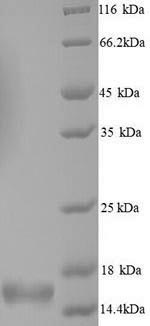CUSABIO used the Human Alpha-synuclein/SNCA DNA sequence encoding amino acids 1-140 to generate a fusion protein with an N-terminal 6xHis-tag. The resulting recombinant full-length protein was produced in the yeast. It was subjected to SDS-PAGE (15% gel) under reducing conditions and presented a molecular mass band of about 17 kDa on the gel. Its purity is over 90%. In addition to specific antibody production, this recombinant SNCA protein may be applied in the studies of synucleinopathies.
Human SNCA is an abundant neuronal protein primarily expressed in the brain, especially in the neocortex, hippocampus, substantia nigra (SN), thalamus, and cerebellum. It exerts diverse functions in multiple biological processes, such as inhibition of apoptosis in dopaminergic neurons, involvement in neuronal differentiation and dopamine metabolism, modulation of glucose levels and calmodulin activity, maintenance of polyunsaturated fatty acids levels, and neurotransmitter release and synaptic plasticity. Overexpression of SNCA leads to its accumulation as misfolded oligomers and large aggregates, thus triggering neurodegenerative diseases, such as Parkinson's disease (PD).






